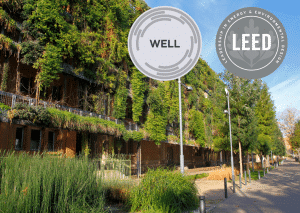Civil Engineering
The built environment around us represents civil engineering. Right from roads, railways, power supply to schools, offices and hospitals, everything is the product of civil engineering.
Technically, civil engineering is a professional engineering discipline that deals with the design, construction, and maintenance of the physical and naturally built environment, including public works such as roads, bridges, canals, dams, airports, sewerage systems, pipelines, structural components of buildings, and railways.
It is the second oldest engineering discipline after military engineering and takes place in the public sector from municipal through to national governments, and in the private sector from individual homeowners through to international companies.
Who are Civil Engineers?
Civil engineers are the people who design, build, and supervise infrastructure projects and systems. They generally work in a variety of locations and conditions. It is common for them to split their time between working in an office and working outdoors at construction sites so that they can monitor operations or solve problems onsite.
Therefore, it is very important for a civil engineer to not just have a high standard of engineering knowledge but also supervisory and administrative skills.
What does a Civil Engineer do?
Civil engineers conceive, design, build, supervise, operate, construct and maintain infrastructure projects and systems in the public and private sector, including roads, buildings, airports, tunnels, dams, bridges, and systems for water supply and sewage treatment. Many civil engineers work in planning, design, construction, research, and education.
Civil engineers typically do the following:
- Analyze long range plans, survey reports, maps, and other data to plan and design projects
- Consider construction costs, government regulations, potential environmental hazards, and other factors during the planning and risk-analysis stages of a project
- Compile and submit permit applications to local, state, and federal agencies, verifying that projects comply with various regulations
- Oversee and analyze the results of soil testing to determine the adequacy and strength of foundations
- Analyze the results of tests on building materials, such as concrete, wood, asphalt, or steel, for use in particular projects
- Prepare cost estimates for materials, equipment, or labor to determine a project’s economic feasibility
- Use design software to plan and design transportation systems, hydraulic systems, and structures in line with industry and government standards
- Perform or oversee surveying operations to establish building locations, site layouts, reference points, grades, and elevations to guide construction
- Manage the repair, maintenance, and replacement of public and private infrastructure
Civil engineers also must present their findings to the public on topics such as bid proposals, environmental impact statements, or property descriptions.
Types of Civil Engineers
Civil engineers can be broadly classified into six categories:
- Structural Engineers: Structural engineers focus mainly on analysis and design of structures like buildings, bridges. They analyze how such structures can hold up to environmental factors like floods, winds and earthquakes.
- Geotechnical Engineers: A geotechnical engineer is trained to incorporate science and technology in the creation of projects and finding of solutions to problems that relate to geology. They focus on construction projects such as tunnels, mines, embankments as well as structural foundations.
- Environmental Engineers: An environmental engineer analyses environmental problems and goes ahead to develop and create solutions to such problems. This field combines the study of disciplines such as science, mathematics, hydrology and atmospheric sciences.
- Water Resources Engineers: A water resources engineer seeks to improve the quantity and quality of water resources and water. These engineers concentrate primarily on flood and storm water analysis, groundwater remediation, water supply and planning, wastewater treatment procedures.
- Construction Engineers: Construction engineers manage construction projects, ensuring that they are scheduled and built in accordance with plans and specifications. These engineers typically are responsible for the design and safety of temporary structures used during construction. They may also oversee budgetary, time-management, and communications aspects of a project.
- Transportation Engineers: A transportation engineer is responsible for the design, construction and maintenance of railways, highways, ports, airfields and several other structures that facilitate transportation. Apart from that, they also help in improving the control of traffic by coming up with new methods and ways of controlling traffic.
Civil Engineering and Green Building Materials
Today, with the rapid development of the economy across the globe, construction industry has achieved remarkable results. Civil engineering is increasing in a large number of cities, and it plays a prominent role in promoting urban construction. During the construction aspect of civil engineering, building materials play an important part. Without building materials, it is difficult to make civil construction work normally.
In order to obtain more profits, some enterprises often purchase cheaper materials, which prove to be seriously detrimental to the environment. Therefore, construction enterprises should change their concepts and pay attention to green building materials so that they can be widely used in civil construction to ensure its green nature.
Civil Engineering and Sustainability
Sustainability is defined as the desire to perform activities with minimal depletion of natural resources or bringing about any harmful effect to the environment. Practicing sustainable construction methods will help minimize the harmful effects of construction.
Construction involves activities like use of building materials from various sources, use of machinery, demolition of existing structures, use of huge amounts of power, cutting down of trees etc which can impact the environment in more ways than one.
Civil engineering is a major part of the economy, so it is very essential that sustainable construction practices replace the previously followed conventional construction practices and methods for the overall environmental well-being.
Civil Engineering and LEED Certification
LEED is one of the most popular green building certification programs worldwide designed by the U.S. Green Building Council. It stands for Leadership in Energy and Environmental Design.
LEED provides third-party verification that a particular building or complex was designed and constructed keeping in mind the following parameters:
- Maximum energy savings
- Efficient use of water
- Reduced greenhouse gas emissions
- Healthier indoor air quality
- Increased use of recycled materials
- Optimum utilization of resources and sensitivity to their impacts
- Reduced maintenance and operation costs
Any professional interested in LEED green buildings usually studies the LEED standards in preparation for an accreditation exam. Upon passing the exam, the individual earns a LEED Green Associate credential or a LEED Accredited Professional (AP) credential and is then said to be LEED accredited.
Further, LEED AP credential can be divided into the following categories:
- LEED AP Building Design + Construction – This rating system includes guidelines for new buildings and old buildings undergoing major renovations.
- LEED AP Operations + Maintenance – This category can be used by building owners and operators to measure operations and maintenance as well as make minor improvements.
- LEED AP Interior Design + Construction – This rating system was designed specifically for tenants leasing a portion of a larger building.
- LEED AP Neighborhood Development – This category integrates the principles of smart growth, urbanism, and green building into the first national program for neighborhood design.
- LEED AP Homes – This was specifically designed for single and multi-family residential structures that are three stories or less.
Out of these, LEED AP Building Design + Construction (BD+C) suits professionals with expertise in the design and construction phases of green buildings, serving the commercial, residential, education and healthcare sectors.
So for a civil engineer – the best one is LEED BD+C credential.
Want To Pass The LEED AP Exam? Everything You Need To Crack The LEED AP Exam On Your First Try. Register Today
Is LEED certification important for a Civil Engineer?
As a civil engineer or structural engineer, if you are working on a green building project, then definitely you are going to work on sustainable building strategies and you should be aware of that at the time of construction. A LEED certification will help you to understand these strategies ahead of the start of the project. And thus, you can plan and perform your work accordingly.
Most structural engineers will want to join the LEED certification process early in the design phase to collaborate with the architect and develop a scheme for an efficient structural system.
Please note that having a LEED credential will not necessarily make you a better civil or structural engineer, but it will show your commitment to the field as well as give you a leg up over other candidates. With the growing popularity of LEED, experts believe that the system is here to stay, so one might as well get on board as it shows the commitment one has to green design as defined by the USGBC.
Overall, a LEED certification will not just add value to your CV as an engineer but it will make you think of sustainable practices even in your daily work.
How to get LEED Accredited?
A civil engineer performs a key role in a building project from start to end. He is the one who monitors the entire construction project. Therefore, as a civil engineer, getting LEED accredited will give you the much needed insight into green building methods and techniques that are fast becoming such an integral part of the construction industry.
To become LEED accredited, one needs to pass the LEED exams. These exams are administered by the Green Business Certification Inc. (GBCI) for professionals seeking to earn credentials and certificates. The exams test knowledge based on the U.S. Green Building Council’s LEED Rating Systems.
You have two options for LEED credentialing: Green Associate and Accredited Professional (AP).
For LEED Green Associate exam, you can obtain study materials from the GBCI or read through materials from GBRI, a USGBC Education Partner. Exams are administered through a proctoring company called Prometric, which has testing centers in all major cities around the world.
Once you’ve taken the LEED Green Associate Exam, you can take the AP exam, which is tailored to a specific LEED rating system that includes Building Construction and Design (BD+C), Operations and Management (O+M), Interior Design and Construction (ID+C), Neighborhood Design (ND), and Homes.
There are excellent courses available to aid in preparation for the LEED exams. GBRI offers all-inclusive LEED exam preparation courses for the LEED Green Associate exam, LEED AP BD+C and O+M exams. The courses come with several features to ensure best ways to pass the exam including;
- Study Guide and Online Modules
- Practice Exams containing over 500 practice questions accompanied by explanations, increasing understanding of required principles.
- Live and on-demand access for a full year
- Flashcards & Memorization Charts
- Audio Files
- Reference and study materials
- Instant access
GBRI’s LEED AP exam preparation programs include access to all LEED Green Associate study materials for students interested in taking the combined LEED Green Associate & LEED AP exam. GBRI LEED Exam Prep is taught in the context of a real LEED v4 project giving you the LEED project experience you need to ace the LEED v4 Green Associate and LEED AP Exam.
With inputs from:











